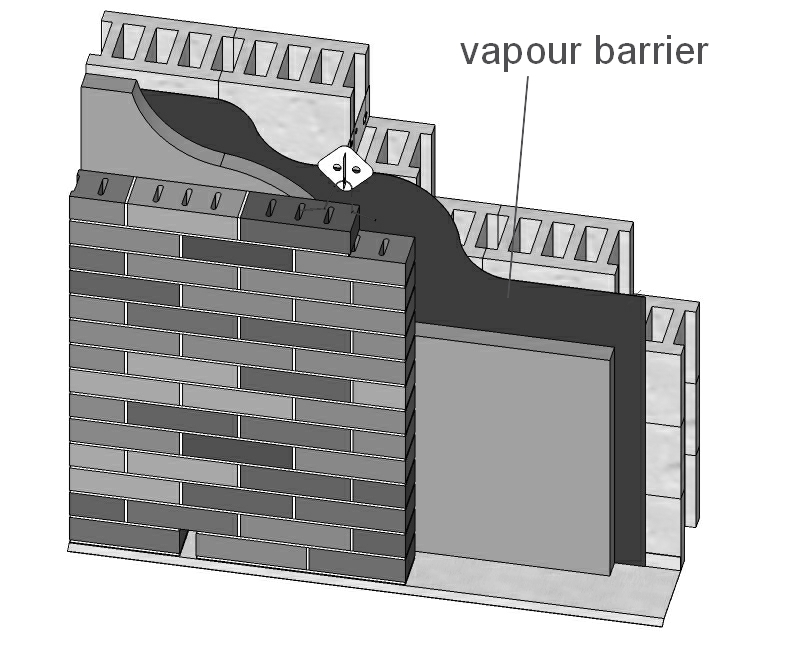Vapour barrier
As warm, moist internal air permeates through the external envelope of a building towards the outside, it will tend to cool. When it reaches its ‘dew point’ temperature, the moisture it holds will begin to condense as water. If this happens within the structure of the building itself, this is known as interstitial condensation.
If interstitial condensation occurs within the inner skin of the building envelope, it can cause problems such as:
- Mould growth, migration of salts, mildew and staining.
- Corrosion and decay of the building fabric.
- Frost damage.
- Poor performance of insulation.
To prevent this, vapour control layers (VCL) or vapour barriers are positioned on the warm side of the structure, preventing the warm moist air from penetrating to a point where it might reach its dew point temperature. In a traditional cavity wall construction for example, a vapour barrier might be introduced between the cavity insulation and the inner masonry skin.
Vapour barriers might also be used in timber frame constructions, roof and floor constructions as well as in high humidity buildings such as swimming pools and factories.
Care must be taken to ensure that vapour barriers are installed properly, so that they are continuous, and that joints, edges, junctions, cuts and penetrations are sealed. Particular care must be taken around openings such as ceiling hatches, and service penetrations such as cables, ducts, sockets, light fittings, and so on.
As well as preventing interstitial condensation, vapour barriers can improve the airtightness of the buildings. However, typically vapour barriers have a very low permeability, but are not completely airtight. Where they are airtight, they may be described as air and vapour control layers (AVCLs). Preventing the passage of air through the structure, can improve its thermal performance. In addition, some vapour barriers may include a low-e (low emissivity) metalised foil in their construction to improve thermal efficiency.
Vapour barriers may include an adhesive face, or adhesive laps and may have some ‘elastomric’ properties, giving a limited self-sealing capability if penetrated.
Some types of rigid foam insulation have a foil bonded to their surface which will act as a vapour barrier, however, care must still be taken to ensure that joints and edges are properly sealed.
NB Approved document C: Site preparation and resistance to contaminants and moisture, 2004 edition incorporating 2010 and 2013 amendments defines a vapour control layer as: ‘Material of construction, usually a membrane, that substantially reduces the water vapour transfer through any building in which it is incorporated.’
[edit] Related articles on Designing Buildings
Featured articles and news
RTPI leader to become new CIOB Chief Executive Officer
Dr Victoria Hills MRTPI, FICE to take over after Caroline Gumble’s departure.
Social and affordable housing, a long term plan for delivery
The “Delivering a Decade of Renewal for Social and Affordable Housing” strategy sets out future path.
A change to adoptive architecture
Effects of global weather warming on architectural detailing, material choice and human interaction.
The proposed publicly owned and backed subsidiary of Homes England, to facilitate new homes.
How big is the problem and what can we do to mitigate the effects?
Overheating guidance and tools for building designers
A number of cool guides to help with the heat.
The UK's Modern Industrial Strategy: A 10 year plan
Previous consultation criticism, current key elements and general support with some persisting reservations.
Building Safety Regulator reforms
New roles, new staff and a new fast track service pave the way for a single construction regulator.
Architectural Technologist CPDs and Communications
CIAT CPD… and how you can do it!
Cooling centres and cool spaces
Managing extreme heat in cities by directing the public to places for heat stress relief and water sources.
Winter gardens: A brief history and warm variations
Extending the season with glass in different forms and terms.
Restoring Great Yarmouth's Winter Gardens
Transforming one of the least sustainable constructions imaginable.
Construction Skills Mission Board launch sector drive
Newly formed government and industry collaboration set strategy for recruiting an additional 100,000 construction workers a year.
New Architects Code comes into effect in September 2025
ARB Architects Code of Conduct and Practice available with ongoing consultation regarding guidance.
Welsh Skills Body (Medr) launches ambitious plan
The new skills body brings together funding and regulation of tertiary education and research for the devolved nation.
Paul Gandy FCIOB announced as next CIOB President
Former Tilbury Douglas CEO takes helm.
UK Infrastructure: A 10 Year Strategy. In brief with reactions
With the National Infrastructure and Service Transformation Authority (NISTA).























